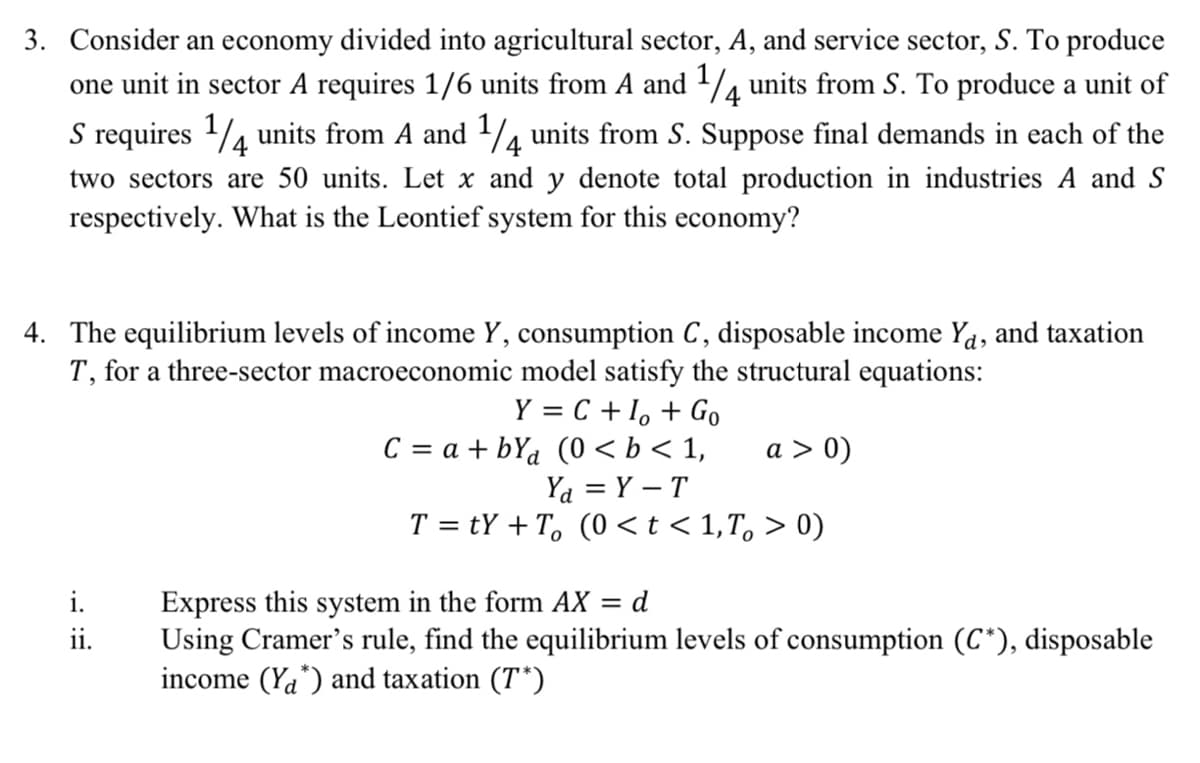Consider an economy divided into agricultural sector, A, and service sector, S. To produce one unit in sector A requires 1/6 units from A and 1/4 units from S. To produce a unit of S requires 14 units from A and 1/4 units from S. Suppose final demands in each of the two sectors are 50 units. Let x and y denote total production in industries A and S respectively. What is the Leontief system for this economy?
Consider an economy divided into agricultural sector, A, and service sector, S. To produce one unit in sector A requires 1/6 units from A and 1/4 units from S. To produce a unit of S requires 14 units from A and 1/4 units from S. Suppose final demands in each of the two sectors are 50 units. Let x and y denote total production in industries A and S respectively. What is the Leontief system for this economy?
Chapter1: Making Economics Decisions
Section: Chapter Questions
Problem 1QTC
Related questions
Question
100%

Transcribed Image Text:3. Consider an economy divided into agricultural sector, A, and service sector, S. To produce
one unit in sector A requires 1/6 units from A and ¼ units from S. To produce a unit of
S requires 1/4 units from A and 1/4 units from S. Suppose final demands in each of the
two sectors are 50 units. Let x and y denote total production in industries A and S
respectively. What is the Leontief system for this economy?
4. The equilibrium levels of income Y, consumption C , disposable income Ya, and taxation
T, for a three-sector macroeconomic model satisfy the structural equations:
Y = C + 1, + Go
C = a + bYa (0 < b < 1,
Ya = Y – T
T = tY +T, (0 <t< 1,T, > 0)
a > 0)
Express this system in the form AX = d
Using Cramer's rule, find the equilibrium levels of consumption (C*), disposable
income (Ya*) and taxation (T*)
i.
ii.
Expert Solution
This question has been solved!
Explore an expertly crafted, step-by-step solution for a thorough understanding of key concepts.
This is a popular solution!
Trending now
This is a popular solution!
Step by step
Solved in 2 steps

Knowledge Booster
Learn more about
Need a deep-dive on the concept behind this application? Look no further. Learn more about this topic, economics and related others by exploring similar questions and additional content below.Recommended textbooks for you


Principles of Economics (12th Edition)
Economics
ISBN:
9780134078779
Author:
Karl E. Case, Ray C. Fair, Sharon E. Oster
Publisher:
PEARSON

Engineering Economy (17th Edition)
Economics
ISBN:
9780134870069
Author:
William G. Sullivan, Elin M. Wicks, C. Patrick Koelling
Publisher:
PEARSON


Principles of Economics (12th Edition)
Economics
ISBN:
9780134078779
Author:
Karl E. Case, Ray C. Fair, Sharon E. Oster
Publisher:
PEARSON

Engineering Economy (17th Edition)
Economics
ISBN:
9780134870069
Author:
William G. Sullivan, Elin M. Wicks, C. Patrick Koelling
Publisher:
PEARSON

Principles of Economics (MindTap Course List)
Economics
ISBN:
9781305585126
Author:
N. Gregory Mankiw
Publisher:
Cengage Learning

Managerial Economics: A Problem Solving Approach
Economics
ISBN:
9781337106665
Author:
Luke M. Froeb, Brian T. McCann, Michael R. Ward, Mike Shor
Publisher:
Cengage Learning

Managerial Economics & Business Strategy (Mcgraw-…
Economics
ISBN:
9781259290619
Author:
Michael Baye, Jeff Prince
Publisher:
McGraw-Hill Education